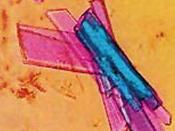The highly competitive attitude of athletes today motivates many athletes to work hard to improve their ability. When their ability has peaked and a performance plateau is reached many turn to supplements to help them reach the next level.
In recent years creatine seems to have become the supplement of choice. Creatine is a compound that is made in the human body and supplies energy to our muscles. Chemically it is called methylguanid-acetic acid and it is formed from the amino acids methoinine and glycine when they are combined through a chemical process (Phillips 49). It is found in abundance in foods such as meat and fish. In 1993 a creatine supplement especially designed for strength and endurance became available in the United States (Phillips 50).
Creatine is used as a kind of energy source in our bodies. Although the human body produces creatine and it is found in many foods that we eat, many athletes still feel the desire for this supplement.
The biggest reason for this may be that animal muscle seems to be the richest source of creatine, to get the type of results that one can get from using a supplement of creatine, a diet would have to consist of ten pounds of raw steak a day for five days (Phillips).
To understand why supplementing creatine may improve strength and ability then it is important to understand the role it plays in the body. Creatine exists in two forms in the muscle; it exists as creatine and as creatine phosphate. The latter of these makes up two-thirds of the creatine supply. When muscles contract, they use a sort of fuel call adenosine triphosphate or ATP, which provides energy by releasing one of its phosphate molecules. Since there is only enough ATP in the muscle to...



Great
Gives good examples, cites his work etc. correctly. I give it a A+++
1 out of 1 people found this comment useful.